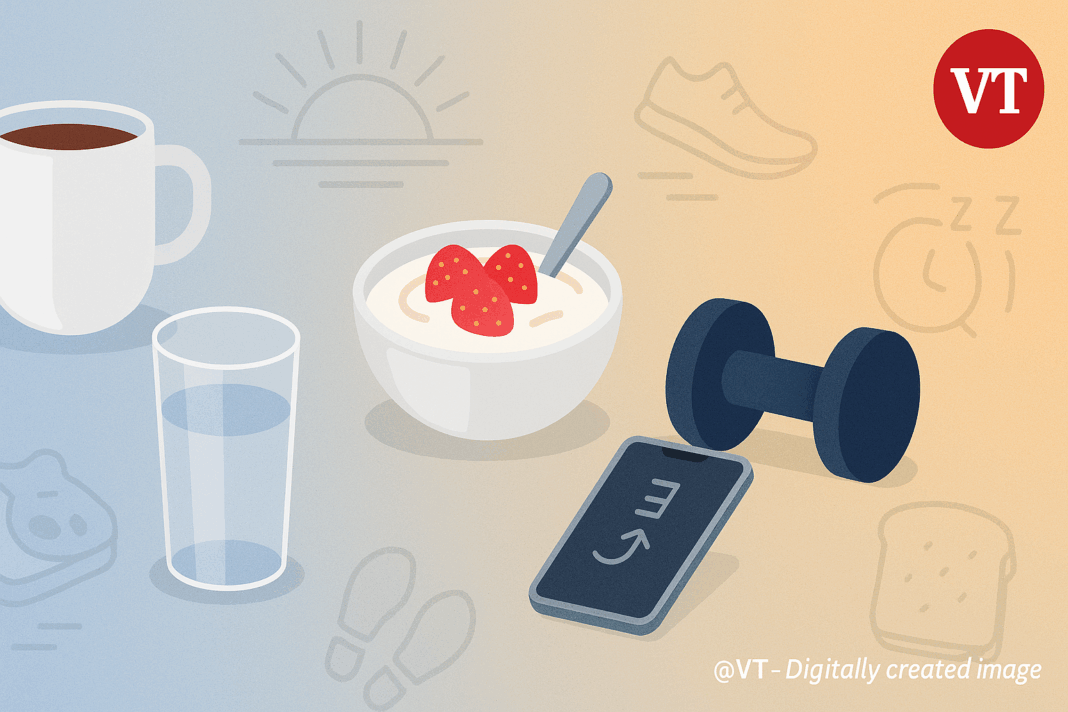The little things you do in the first hour after you wake up can set your hormones, hunger, and energy on a road that might be good or bad. These six frequent practices make you want to eat more, slow down your metabolism, and snack more later in the day. The fixes are easy to do and make sense.
1) Drink coffee before you drink water.
Why it doesn’t work: You wake up feeling a bit thirsty. If you go straight to caffeine, it can quickly raise cortisol levels. Cortisol is a hormone that gives you energy and is also a stress hormone. This could give you a boost right now and make you hungry later, especially if you haven’t eaten yet.
Do this instead: First, drink a glass of water, either plain or mineral. After breakfast, drink coffee or have it with breakfast.
Source: Psychosomatic Medicine (Lovallo et al., 2005).
2) A breakfast with a lot of sugar instead of protein
Why it doesn’t work: Pastries, sweet cereal, and juice are all examples of breakfasts that are high in sugar and low in protein. These foods offer you a sudden burst of glucose, which makes you want to eat in the middle of the morning. Studies demonstrate that breakfasts with more protein stop hunger hormones and make people eat less over the day.
Instead, try this: Add fiber (like berries, oats, or whole-grain bread) to your breakfast, which should have 20–30 grams of protein (such eggs, Greek yogurt, cottage cheese, or tofu).
Source: Heather Leidy’s study on breakfasts with more protein.
3) Scrolling before the sun rises
Why it doesn’t work: You miss the glorious morning light that sets your body clock if you stay inside and look at your phone. Getting more light in the morning for longer durations of time is connected to a reduced BMI on its own.
Instead, do this: Even if it’s cloudy, go outside for 10 to 20 minutes within an hour of getting up. After that light, look at your phone.
Source: the Northwestern Medicine study in PLOS ONE (Reid et al., 2014).
4) Moving without stopping
Why it doesn’t work: Sitting sitting for a long time in the morning makes insulin less effective and raises blood sugar levels higher after meals, which makes cravings greater. Walking for a short time after a meal lowers blood sugar and insulin levels.
Instead, take a five- to ten-minute stroll after breakfast, or do “snacks” of activity for two to five minutes every half hour.
Source: “Diabetes Care” (Dunstan et al., 2012).
5) Eating carbs first thing in the morning without anything else
Why it doesn’t work: If you eat only refined carbs when you are fasting, your blood sugar levels could change quickly, which could make you hungry. When you eat carbs with protein, fat, and fiber, your body takes longer to break them down. This helps you stay energized.
Put protein (like eggs, yogurt, or nut butter) and fiber (like chia, flax, or fruit) on your toast or porridge instead.
Source: the Nutrition Source at the Harvard T.H. Chan School of Public Health on carbohydrates and blood sugar. You can also read about macronutrient matching in clinical research.
6) Hitting the snooze button
Why it doesn’t work: Alarms that go off more than once wake you up and make “sleep inertia” last longer. This is the tired, low-energy feeling that makes you want to eat more and move less.
Do this instead: Set one alarm for the most realistic time, get up immediately away, and keep to the same wake-up time every day, including on the weekends.
Source: “How using a snooze alarm changes sleep inertia after…”.
The goal is to start straight away.
- First, drink water, and then eat meals with coffee.
- Eat a breakfast that is high in protein, fiber, and slow carbs. Get some sun outside for 10 to 20 minutes in the morning. Save the screens for later.
- Get up and move about a bit after breakfast and every half hour you’re sitting.
- Don’t eat “naked” sweets; instead, eat carbs that have protein, fat, or fiber in them. Every day at the same time, one alarm goes off.
A global media for the latest news, entertainment, music fashion, and more.















